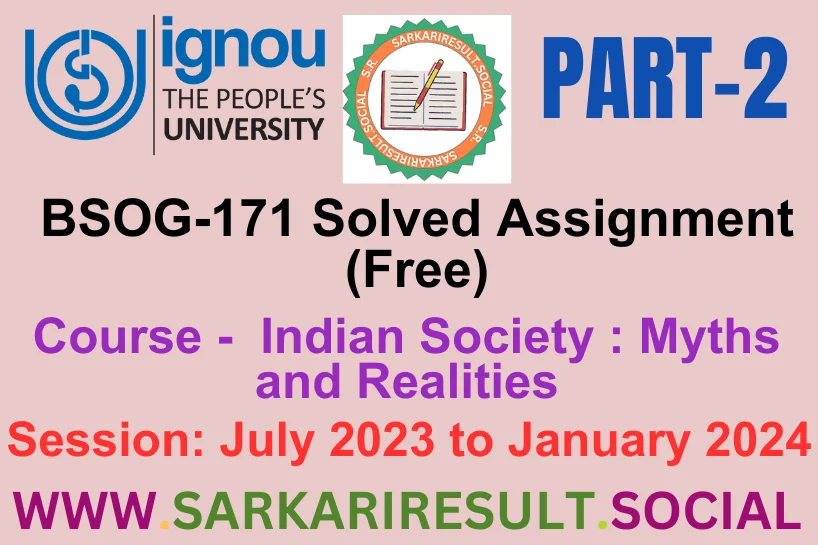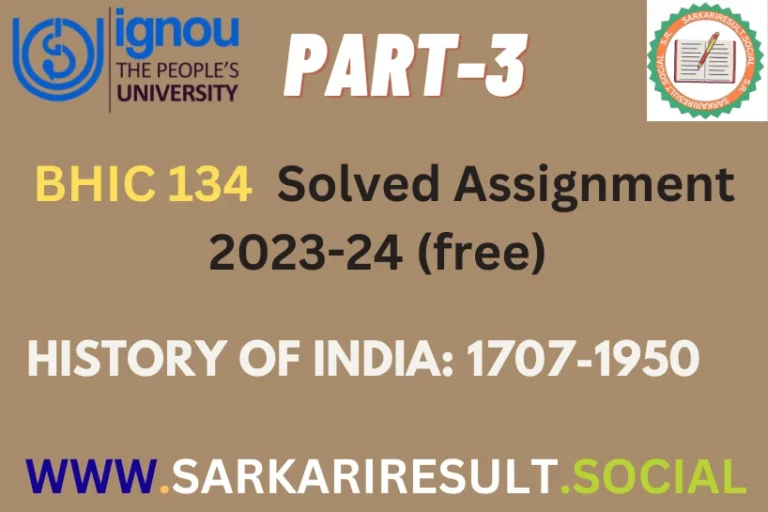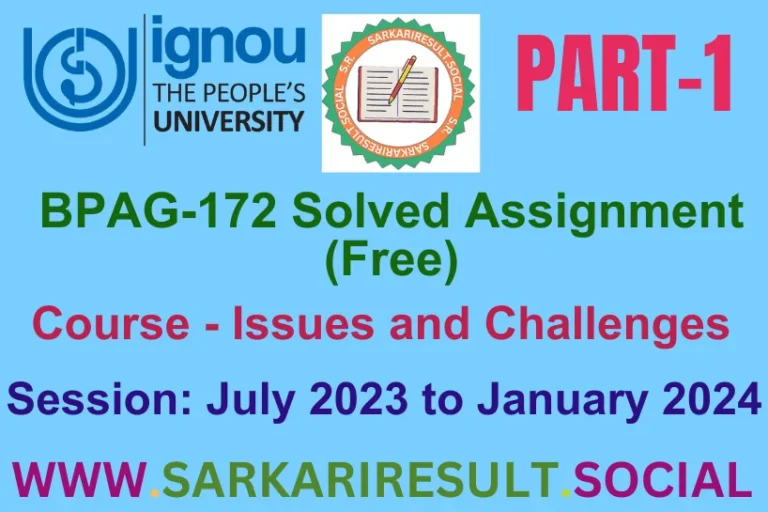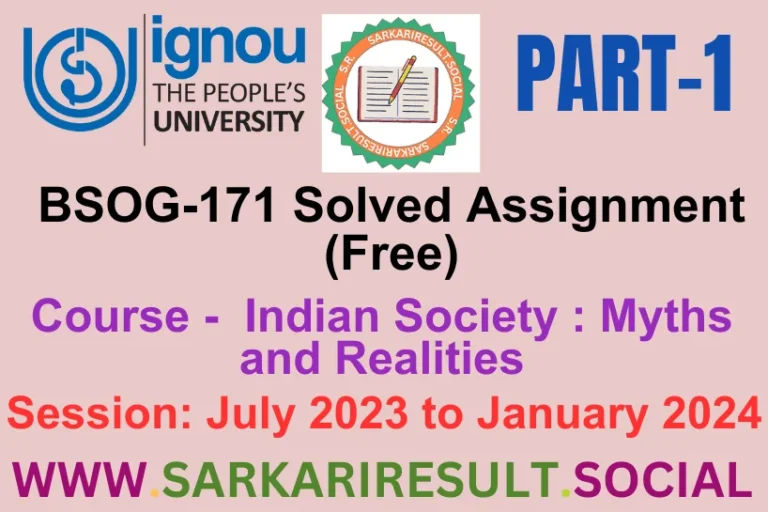BSOG 171 SOLVED IGNOU ASSIGNMENT FREE PART 2

Welcome to the BSOG 171 SOLVED IGNOU ASSIGNMENT FREE PART 2 TMA. Assignment B streamlines your approach with concise answers to three pivotal questions. In about 250 words each, explore the nature of legal unification by the British in India, delve into matrilineal groups in North East India, and understand how the Constitution of India safeguards linguistic diversity. Our IGNOU Solved Assignments 2024 for this section serve as your creative guide.

Answer the following questions in about 250 words each.
Q.3 Explain the nature of legal unification brought about by the British in India.
Ans. The legal unification brought about by the British in India was a complex process that aimed to establish a uniform legal system across the diverse territories under their control. This legal transformation was a crucial aspect of British colonial governance, and it had profound implications for the socio-political fabric of the subcontinent.
1. Introduction of English Law:
– Imposition of English Common Law: The British introduced English Common Law as the foundational legal framework, serving as the basis for judicial decisions. This was a departure from the pluralistic legal traditions that existed in different regions of India.
2. Codification of Laws:
– Creation of Uniform Codes: The British undertook the monumental task of codifying laws to ensure consistency. Land revenue laws, criminal laws, and civil laws were codified to bring a standardized legal system.
– Indian Penal Code (IPC) and Criminal Procedure Code (CrPC): The IPC and CrPC were enacted in the mid-19th century, serving as comprehensive legal instruments applicable throughout India.
3. Introduction of Courts and Judicial System:
– Establishment of Courts: British India saw the establishment of a hierarchical system of courts, from the district level to the High Courts. These courts applied English law and heard cases based on the principles of equity and justice.
– Separation of Judicial and Executive Functions: The British aimed for the separation of judicial and executive functions, a departure from traditional systems where local rulers often had both administrative and judicial powers.
4. Uniform Administrative Structure:
– Appointment of British Judges: British judges were appointed to preside over the higher courts, contributing to the uniform application of law across regions.
– Role of Indian Judges: Over time, Indians were included in the judiciary, although British judges continued to hold significant positions.
5. Impact on Personal Laws:
– Uniformity in Criminal Laws: The criminal laws applied uniformly, irrespective of religious or regional differences, leading to a standardized approach in dealing with crimes.
– Diversity in Personal Laws: However, personal laws related to family matters, such as marriage, inheritance, and succession, were allowed to follow religious customs, leading to a dual legal system in these areas.
6. Legacy and Criticisms:
– Legal Legacy: The British legal system left a lasting impact on independent India. The Indian legal system, post-independence, retained many elements of the British legal framework.
– Criticisms: Critics argue that the British legal unification was often a tool of control, imposing Western legal norms without adequate sensitivity to indigenous traditions. The uniformity achieved was selective and did not extend comprehensively to all aspects of Indian society.
In summary, the legal unification brought about by the British in India aimed at establishing a standardized legal system but was not without complexities and criticisms. It laid the groundwork for a legal legacy that continues to shape India’s legal landscape today.
Q.4 Write a note on matrilineal groups in North east India.
Ans. Matrilineal societies in Northeast India, particularly among various tribes, have distinct social structures where lineage and inheritance are traced through the maternal line. These matrilineal groups contribute to the region’s cultural diversity and showcase alternative kinship systems.
1. Khasi and Jaintia Tribes:
– Meghalaya: The Khasi and Jaintia tribes in Meghalaya predominantly follow matrilineal traditions. Lineage is determined through the maternal side, and property is often passed down to the youngest daughter.
2. Garos:
– Meghalaya and Assam: The Garo community, found in parts of Meghalaya and Assam, also practices matrilineality. Descent, inheritance, and family ties are linked to the mother’s side.
3. Apatani Tribe:
– Arunachal Pradesh: The Apatani tribe in Arunachal Pradesh is known for its matrilineal practices. The family property is inherited by the youngest daughter, and children take the mother’s clan name.
4. Khasi Hills and Karbi Anglong:
– Assam: In parts of Assam, particularly in the Khasi Hills and Karbi Anglong region, matrilineal systems are observed among certain communities. The maternal line plays a crucial role in social organization.
5. Nair Community:
– Manipur: In parts of Manipur, the Nair community practices matrilineality. Family lineage and inheritance are traced through the mother, and property often passes to daughters.
6. Mizo Community:
– Mizoram: The Mizo community in Mizoram showcases matrilineal aspects in their social structure. Lineage, property inheritance, and family ties are primarily linked to the maternal line.
7. Social Implications:
– Women’s Status: Matrilineal systems often lead to higher social status for women. They play significant roles in family and community decisions, challenging traditional patriarchal norms.
– Property Inheritance: The practice of property passing through the female line contributes to economic empowerment for women within these communities.
8. Challenges and Changes:
– Changing Dynamics: While matrilineal traditions persist, modern influences and changing dynamics have introduced elements of patrilineal practices in some instances.
– Impact of Education: Education and exposure to external influences have brought about shifts in gender roles within these societies.
In conclusion, matrilineal groups in Northeast India exemplify the region’s cultural diversity. These societies offer unique insights into alternative kinship systems, challenging conventional norms and emphasizing the importance of the maternal line in determining lineage, inheritance, and social organization.
Q.5 How does the Constitution of India safeguard the linguistic diversity of India?
Ans. The Constitution of India recognizes and safeguards the linguistic diversity of the country by incorporating several provisions that uphold the rights of linguistic minorities and promote the use of different languages. Here are key ways in which the Constitution achieves this:
1. Article 29 and 30:
– Cultural and Educational Rights: Article 29 and 30 of the Constitution provide cultural and educational rights to linguistic minorities. They ensure that any section of citizens having a distinct language, script, or culture has the right to conserve and develop it.
2. Eighth Schedule:
– Recognition of Languages: The Eighth Schedule of the Constitution lists 22 officially recognized languages, including Hindi, Bengali, Telugu, Marathi, Tamil, Urdu, and others. States and Union Territories can also declare additional official languages for local use.
3. Article 347:
– Special Provision for Language Spoken by a Section of the Population: Article 347 allows the President to recognize a language spoken by a section of the population in a particular state as an official language of that state.
4. Official Language Provisions:
– Hindi and English as Official Languages: While Hindi is recognized as the official language of the Indian government, English is allowed to be used for official purposes, including Parliamentary proceedings, making the administration accessible to people who may not be well-versed in Hindi.
5. Language of the Supreme Court:
– Choice of Language in Supreme Court: The Supreme Court of India allows litigants to submit their petitions in any of the languages mentioned in the Eighth Schedule, ensuring linguistic inclusivity.
6. Language of Legislation:
– Usage of State Languages in Legislation: States and Union Territories can legislate in their official languages, making legal documents accessible to the local population.
7. Promotion of Hindi:
– Directive to Promote Hindi: Article 351 directs the Indian government to promote the spread and development of Hindi, ensuring the development and enrichment of Hindi language and literature.
8. Language Commissions:
– Formation of Language Commissions: Some states have established language commissions to safeguard linguistic rights and promote the development of languages.
9. Right to Education:
– Mother Tongue as a Medium of Instruction: The Right to Education Act recognizes the importance of the mother tongue as a medium of instruction, especially at the primary level.
In essence, the Constitution of India embeds a framework that acknowledges and protects the linguistic diversity of the country. By granting cultural and educational rights, recognizing multiple official languages, and allowing flexibility in the use of languages, the Constitution ensures that the rich tapestry of linguistic heritage in India is preserved and celebrated.
Also See This: BSOG 171 SOLVED IGNOU ASSIGNMENT FREE PART 3







